It looks like you're using an Ad Blocker.
Please white-list or disable AboveTopSecret.com in your ad-blocking tool.
Thank you.
Some features of ATS will be disabled while you continue to use an ad-blocker.
share:
First off let me apologize for the sound, apparently Brien Foerster wasn't aware at the time of filming that it was so horrible.
The video's premise is basically this, that during some digging on one of the main streets [Inca road] to put in fiber optic cables [or plumbing?] in the ancient city of Cusco Peru they have revealed an older buried site. Again, the sound is horrible but the video quality isn't bad and if you look closely you can surely see, blocks, walls and a stairway down. There is no telling just how old these revealed ruins really are because as you can clearly see the work is being carried out without care for the find. No carbon dating, no archeological investigation etc.
Now, to be fair, they may have just found a slightly older [or even from the same period] structure/location as old as the city of Cusco itself but, this does open the possibility that the buried site is actually just a small sampling of a much larger and still unexplored even older site under Cusco. I doubt we'll hear or see much more about it in the media. Brien, being an avid Ancient Peruvian site visitor just happened to be there with his camera and lucky for us caught it on film while the work was being carried out.
So
For your viewing pleasure.
As always,
Stay tuned.
The video's premise is basically this, that during some digging on one of the main streets [Inca road] to put in fiber optic cables [or plumbing?] in the ancient city of Cusco Peru they have revealed an older buried site. Again, the sound is horrible but the video quality isn't bad and if you look closely you can surely see, blocks, walls and a stairway down. There is no telling just how old these revealed ruins really are because as you can clearly see the work is being carried out without care for the find. No carbon dating, no archeological investigation etc.
Now, to be fair, they may have just found a slightly older [or even from the same period] structure/location as old as the city of Cusco itself but, this does open the possibility that the buried site is actually just a small sampling of a much larger and still unexplored even older site under Cusco. I doubt we'll hear or see much more about it in the media. Brien, being an avid Ancient Peruvian site visitor just happened to be there with his camera and lucky for us caught it on film while the work was being carried out.
So
For your viewing pleasure.
Cusco Peru is of course well known as the capital of the Inca, from 1100 to 1533 AD. However, new excavations of a major Inca road has shown that an even more ancient city may lay below the Inca capital...
As always,
Stay tuned.
edit on 26-10-2014 by SLAYER69 because: (no reason given)
Wow!
That's the phoniest looking photoshopped skull I've seen yet!
It's even got hair. LOL
That's the phoniest looking photoshopped skull I've seen yet!
It's even got hair. LOL
a reply to: SLAYER69
Thanks for posting this, Slayer. Sites like this make me wonder how many sites around the world were built on top of sites that were already ancient at the time. Somewhere I read that the city of Jericho has been rebuilt several times throughout the millennia, one on top of the other. I don't know how true that is, or what the latest finds are at that site, but it's a fair example. Also, we know that the ancients often built on top of, or over sites they considered sacred. So I think it's fair to say, there could be some of the oldest sites in the world hidden under ruins we are even now excavating.
As Brien mentioned in the video, and you have said previously, the older sites are often superior in workmanship and architecture. And in many cases, much larger stones were used. What happened that changed everything? Why wasn't this knowledge passed down through the generations? Could it be that little known or understood catastrophes like the following changed the whole direction of the ancient world, and much knowledge was lost and/or abandoned?
Why is the global climatic cataclysm of the sixth century virtually unheard of?
Note that the years 535-536 are not written in stone, as it were. There seems to be some inconsistencies in dating from documents of the time.
ETA: From the comments section below the article...
Thanks for posting this, Slayer. Sites like this make me wonder how many sites around the world were built on top of sites that were already ancient at the time. Somewhere I read that the city of Jericho has been rebuilt several times throughout the millennia, one on top of the other. I don't know how true that is, or what the latest finds are at that site, but it's a fair example. Also, we know that the ancients often built on top of, or over sites they considered sacred. So I think it's fair to say, there could be some of the oldest sites in the world hidden under ruins we are even now excavating.
As Brien mentioned in the video, and you have said previously, the older sites are often superior in workmanship and architecture. And in many cases, much larger stones were used. What happened that changed everything? Why wasn't this knowledge passed down through the generations? Could it be that little known or understood catastrophes like the following changed the whole direction of the ancient world, and much knowledge was lost and/or abandoned?
Why is the global climatic cataclysm of the sixth century virtually unheard of?
There was a sign from the sun, the like of which had never been seen and reported before. The sun became dark and its darkness lasted for 18 months. Each day, it shone for about four hours, and still this light was only a feeble shadow. Everyone declared that the sun would never recover its full light again. Historiae Ecclesiasticae
Between the years 535 and 536, a series of major global climatic events that took place that could easily be described as a global cataclysm with catastrophic consequences. The above abstract is from the sixth century historian and church leader, John of Ephesus, in his historical work, Church Histories (‘Historiae Ecclesiasticae’).
John of Ephesus is not the only one that mentions this event. Procopius lived between 500 and 565 AD and he was a late antiquities scholar and one of the main historians of the 6th century. He also refers to the strange behaviour of the sun and believed that it was a bad sign and the beginning of other events.
Note that the years 535-536 are not written in stone, as it were. There seems to be some inconsistencies in dating from documents of the time.
ETA: From the comments section below the article...
It has been established that a comet passed over Britain in AD652(typo: should be 562), and impacted in Bolivia. There is a 6 mile debris field in the mountains of Bolivia. For years the signs had been misinterpreted, until today's testing techniques are now able to make sense of the evidence. Britain experienced a mass exodus at this time, and nothing grew for a decade. This was the Dark Ages. Gildas has chronicled these events, and it also explains why the ancient British language is found in parts of Brittany, where the British fled to. Gildas is also buried at a monastery in Brittany.
edit on 10/26/2014 by Klassified because: ETA
South and Central America have yet to reveal all of their hidden treasures. As the "old guard" of archaeology and anthropology pass away, slowly
the past finds are being questioned as to their dates of activity and new views that disagree with the Clovis theory are being explored as not only
possible, but probable.
The evidence is everywhere. For what, I can't claim to know, but civilization is much older than 10,000 years.
Once again great find Slayer...
The evidence is everywhere. For what, I can't claim to know, but civilization is much older than 10,000 years.
Once again great find Slayer...
Great new find!
It's hard not to be fascinated by Peru and the literal depths of ancient culture.
The difference in the stonework (older the better is so interesting). What happened that we lost that construction knowledge???
Here are a few more links on this find.
Look at the difference in these first 2 pics (showing the excavation of the same area)
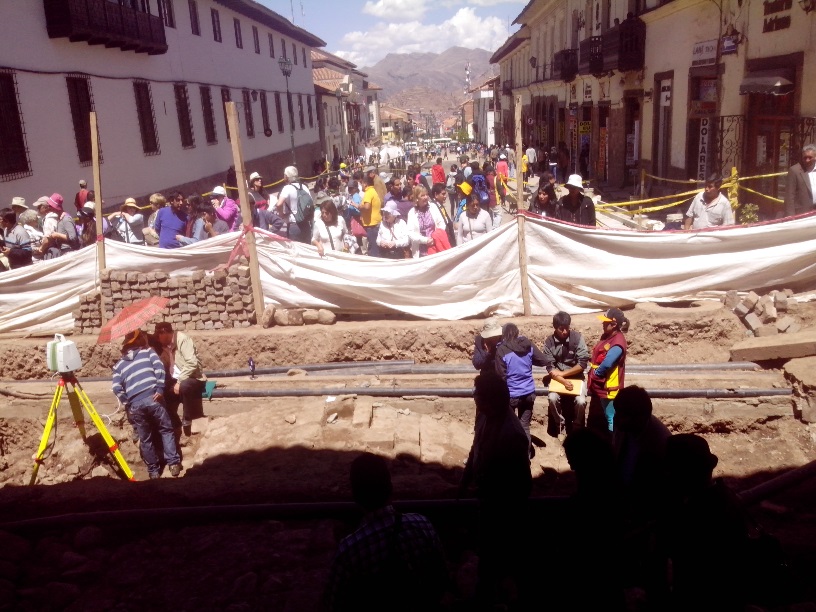
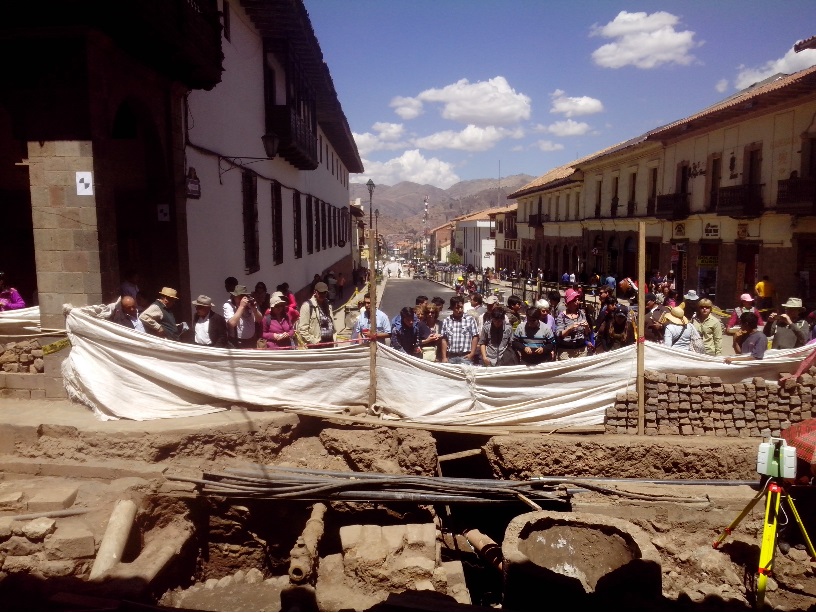
The stonework


wakeup-world.com...
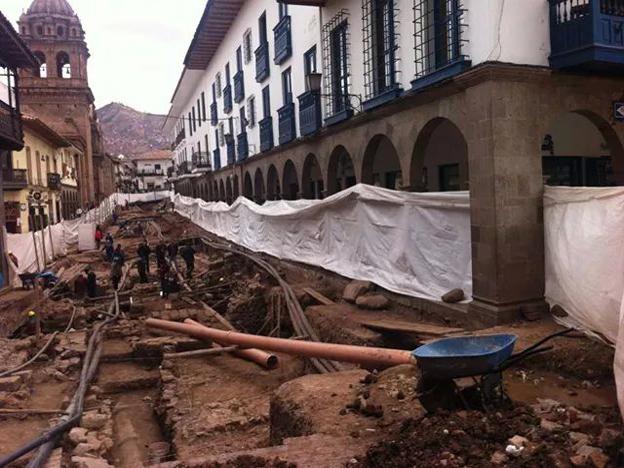
www.peruthisweek.com...
The Decentralized Direction of Culture of Cusco (DDCC) has called United Nations Educational, Scientific and Cultural Organization (UNESCO) to evaluate the site.
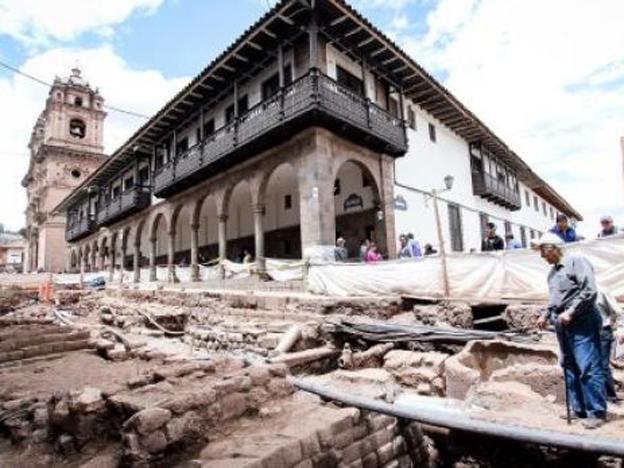
www.peruthisweek.com...
Thanks Slayer *F
It's hard not to be fascinated by Peru and the literal depths of ancient culture.
The difference in the stonework (older the better is so interesting). What happened that we lost that construction knowledge???
Here are a few more links on this find.
Look at the difference in these first 2 pics (showing the excavation of the same area)


The stonework


wakeup-world.com...

www.peruthisweek.com...
The Decentralized Direction of Culture of Cusco (DDCC) has called United Nations Educational, Scientific and Cultural Organization (UNESCO) to evaluate the site.

www.peruthisweek.com...
Thanks Slayer *F
a reply to: Psynic
Hair on skeletal remains happens.
“Once the body has reached the skeletal stage all that remains are bones, teeth and hair and from these DNA samples can be gathered in order to try and make identification.”
www.exploreforensics.co.uk...
Hair on skeletal remains happens.
“Once the body has reached the skeletal stage all that remains are bones, teeth and hair and from these DNA samples can be gathered in order to try and make identification.”
www.exploreforensics.co.uk...
a reply to: SLAYER69
I remember reading about what they found under Cuzco while performing excavations right in the main streets of the city. The structures were considered Inca, by local experts.
I think they were located next to Hawkaypata, which was the original main square. If I remember well, the discovery is so extense and bad located that they wre thinking about cover it all again. Not sure if that happened already.
Some photos here :
www.andina.com.pe...
elcomercio.pe...
I remember reading about what they found under Cuzco while performing excavations right in the main streets of the city. The structures were considered Inca, by local experts.
I think they were located next to Hawkaypata, which was the original main square. If I remember well, the discovery is so extense and bad located that they wre thinking about cover it all again. Not sure if that happened already.
Some photos here :
www.andina.com.pe...
To continue with the works, the area will be covered with a special treatment that would be coordinated by specialists Decentralized Management Culture of Cusco.
elcomercio.pe...
ed
it on 26-10-2014 by Trueman because: (no reason given)
a reply to: SeekingDepth
Thank you for posting the images and links for us. I meant to post some images but got sidetracked with some stuff needing to be done around the house. *Translation* leolady had me hanging curtains.
Awesome contribution.
Thank you for posting the images and links for us. I meant to post some images but got sidetracked with some stuff needing to be done around the house. *Translation* leolady had me hanging curtains.

Awesome contribution.
edit on 26-10-2014 by SLAYER69 because: (no reason given)
originally posted by: SeekingDepth
a reply to: Psynic
Hair on skeletal remains happens.
“Once the body has reached the skeletal stage all that remains are bones, teeth and hair and from these DNA samples can be gathered in order to try and make identification.”
www.exploreforensics.co.uk...
Pulleaze!
It's still got a part!
Not saying anything about the rest of the OP, but the title screen is a very poorly done, photoshop job.
a reply to: SLAYER69
#### it Slay, I'm driven down there tomorrow !
Want to go? We'll just go down there and and start
dig'n #### up! I'll do all the work!
We'll pick up Best in show and be gone gone gone baby!
#### it Slay, I'm driven down there tomorrow !
Want to go? We'll just go down there and and start
dig'n #### up! I'll do all the work!
We'll pick up Best in show and be gone gone gone baby!
edit on Ram102614v502014u02 by randyvs because: (no reason given)
We tend to build where others have built before. Maybe it is because of environmental reasons like water or supplies, maybe it is because of fertile
soils or food. Or maybe it is we sense something about the area.
We also avoid some areas for some reason. I think energy signatures from the earth are involved. We do not feel at home in some places.
We also avoid some areas for some reason. I think energy signatures from the earth are involved. We do not feel at home in some places.
These ruins are very interesting, but it comes as no surprise really....When we think the earth is billions of years old....
what civilisations preceeded us in all that span......I tend to think we are the current, but not the last in the line.....
The ruined city under the city is somehow to be expected in such places......cool find Slay!
what civilisations preceeded us in all that span......I tend to think we are the current, but not the last in the line.....
The ruined city under the city is somehow to be expected in such places......cool find Slay!
originally posted by: rickymouse
We tend to build where others have built before. Maybe it is because of environmental reasons like water or supplies, maybe it is because of fertile soils or food. Or maybe it is we sense something about the area.
We also avoid some areas for some reason. I think energy signatures from the earth are involved. We do not feel at home in some places.
Exactly!
Mexico City is the Prime example.
the Aztecs built over what was there and the sprawling Metropolis on top of that!
If only we spent a fraction of our money to dig to find our common ancestry instead of spending to find new and improved ways to kill, it could introduce a new Understanding of Who We Are from the ruins of Who We Were.
And Randyvs...I'm free to run screens for pottery shards. If you can secure funding for food, shelter, and transport. I have experience in archaeology.
a reply to: the owlbear
I would bet that many of our cities were built right over old cities here in America. The blocks building the old ruined cities were probably incorporated in some of the oldest building. It was easier to build with rocks that were already there, piled up. We wonder where the evidence is but do not understand that early settlers repurposed these stones, destroying evidence as they did. If I found an old rock foundation and walls in the woods by my house twenty years ago, I would have made something out of it. That is before I was interested in this sort of things, my interests then were building things to store my stuff.
I would bet that many of our cities were built right over old cities here in America. The blocks building the old ruined cities were probably incorporated in some of the oldest building. It was easier to build with rocks that were already there, piled up. We wonder where the evidence is but do not understand that early settlers repurposed these stones, destroying evidence as they did. If I found an old rock foundation and walls in the woods by my house twenty years ago, I would have made something out of it. That is before I was interested in this sort of things, my interests then were building things to store my stuff.
a reply to: SLAYER69
Brilliant thread, thank you it seem's sad that these country's are so apethetic to the possibility themselves of an older site as such could spin even more tourism and produce an increase in tourists if they were to research and conserve such site's, I like what he pointed out about the older stones being superior at the base with the later inca stone work inferior on top.
Brilliant thread, thank you it seem's sad that these country's are so apethetic to the possibility themselves of an older site as such could spin even more tourism and produce an increase in tourists if they were to research and conserve such site's, I like what he pointed out about the older stones being superior at the base with the later inca stone work inferior on top.
a reply to: Klassified
Very interesting.
I've often wondered if the timing of why certain sites around the world seem to have similar situation where the timing of their demise or major political/societal/religious changes occur.
Interesting read, thank you.
Very interesting.
I've often wondered if the timing of why certain sites around the world seem to have similar situation where the timing of their demise or major political/societal/religious changes occur.
Interesting read, thank you.
a reply to: Psynic
apparently you don't know about the climate in Peru,or the burial practices they used.
do you think this is photoshopped
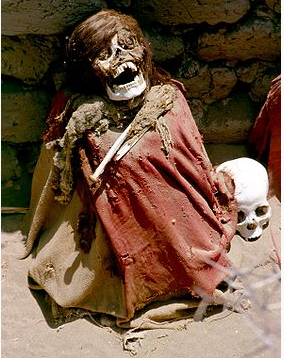
both above are from the wiki, and like i always say cause it's fast.
Chauchilla Cemetery
ETA: check out the star child skull, i bet it was shopped to.
apparently you don't know about the climate in Peru,or the burial practices they used.
do you think this is photoshopped

The bodies are so remarkably preserved due mainly to the dry climate in the Peruvian Desert but the funeral rites were also a contributing factor. The bodies were clothed in embroidered cotton and then painted with a resin and kept in purpose-built tombs made from mud bricks. The resin is thought to have kept out insects and slowed bacteria trying to feed on the bodies.[1]
The nearby site of Estaquería may provide clues to the remarkable preservation of the numerous bodies in these cemeteries. At that site, archeologists found wooden pillars initially thought to have been used for astronomical sightings.[5] However, it is now believed that the posts were used to dry bodies in a mummification process.[2] This may account for the high degree of preservation seen in thousand-year-old bodies which still have hair and the remains of soft tissue, such as skin.
both above are from the wiki, and like i always say cause it's fast.
Chauchilla Cemetery
edit on 26-10-2014 by hounddoghowlie because: (no reason given)
ETA: check out the star child skull, i bet it was shopped to.
edit on 26-10-2014 by hounddoghowlie because: (no reason given)
Interesting topic thanks! s&f
It seems quite often that an older society was very advanced in stonework left behind monuments / cities which were built upon by more recent people who had less skills.
Devo - de-evolution of man?
It seems quite often that an older society was very advanced in stonework left behind monuments / cities which were built upon by more recent people who had less skills.
Devo - de-evolution of man?
a reply to: SLAYER69
Great stuff. And it seems to be a repeating pattern all over the world.
Wasn't it Homer who said "The city of Troy is built upon the city of Troy which was built upon the city of Troy..." etc? I believe archaeologists have found Troy I thru Troy IX thus far...maybe more.
Am going to read up more on this find - thanks!
Great stuff. And it seems to be a repeating pattern all over the world.
Wasn't it Homer who said "The city of Troy is built upon the city of Troy which was built upon the city of Troy..." etc? I believe archaeologists have found Troy I thru Troy IX thus far...maybe more.
Am going to read up more on this find - thanks!
edit on 10/26/2014 by Riffrafter because: (no reason given)
originally posted by: SLAYER69
First off let me apologize for the sound, apparently Brien Foerster wasn't aware at the time of filming that it was so horrible.
The video's premise is basically this, that during some digging on one of the main streets [Inca road] to put in fiber optic cables [or plumbing?] in the ancient city of Cusco Peru they have revealed an older buried site. Again, the sound is horrible but the video quality isn't bad and if you look closely you can surely see, blocks, walls and a stairway down. There is no telling just how old these revealed ruins really are because as you can clearly see the work is being carried out without care for the find. No carbon dating, no archeological investigation etc.
Now, to be fair, they may have just found a slightly older [or even from the same period] structure/location as old as the city of Cusco itself but, this does open the possibility that the buried site is actually just a small sampling of a much larger and still unexplored even older site under Cusco. I doubt we'll hear or see much more about it in the media. Brien, being an avid Ancient Peruvian site visitor just happened to be there with his camera and lucky for us caught it on film while the work was being carried out.
However, new excavations of a major Inca road has shown that an even more ancient city may lay below the Inca capital...
Simple answer yes and these earlier cultures are well known - books have chapters on them......
The Inca started building Cusco around 1450 AD or about 550 years ago; there has been advanced cultures in the region of Peru for over 5,000 years. The earliest signs of hunter-gathers in the Cusco valley go back 7,000 but earlier HG groups go back thousands of years earlier.
So who else was at the Cusco site prior to the Inca?
The Huari (Wari) who built up a culture that went from 550-1100AD
The Killke from 1100 until the Inca 150 years later
Extensive work was done on dating of the pottery found in the valley and from this was established the Cuzco chronology. For those interested in the subject I would suggest looking at the archaeological sites of Chokepukio and Pikillacta.
So all those folks contributed to the city that later became known as Cusco. I would recommend that Brien might, just might want to read a book on the history of Cusco since he doesn't seem to know anything about the basics of what is already known about the city and its history!
lol
edit on 27/10/14 by Hanslune because: (no reason given)
new topics
-
Elites disapearing
Political Conspiracies: 1 hours ago -
A Personal Cigar UFO/UAP Video footage I have held onto and will release it here and now.
Aliens and UFOs: 1 hours ago -
Go Woke, Go Broke--Forbes Confirms Disney Has Lost Money On Star Wars
Movies: 3 hours ago -
Freddie Mercury
Paranormal Studies: 3 hours ago -
Nirvana - Immigrant Song
Music: 8 hours ago -
British TV Presenter Refuses To Use Guest's Preferred Pronouns
Education and Media: 9 hours ago -
Tucker Carlson interviews Christian pastor from Bethlehem.
Middle East Issues: 11 hours ago -
Trump To Hold Dinner with President of Poland At Trump Tower Tonight
2024 Elections: 11 hours ago
top topics
-
British TV Presenter Refuses To Use Guest's Preferred Pronouns
Education and Media: 9 hours ago, 16 flags -
Go Woke, Go Broke--Forbes Confirms Disney Has Lost Money On Star Wars
Movies: 3 hours ago, 11 flags -
Trump To Hold Dinner with President of Poland At Trump Tower Tonight
2024 Elections: 11 hours ago, 8 flags -
Tucker Carlson interviews Christian pastor from Bethlehem.
Middle East Issues: 11 hours ago, 7 flags -
Revolution in advertising: the Russians launched a unique satellite
Science & Technology: 16 hours ago, 5 flags -
A family from Kansas with six children moved to the Moscow region
Other Current Events: 14 hours ago, 5 flags -
Freddie Mercury
Paranormal Studies: 3 hours ago, 5 flags -
A Personal Cigar UFO/UAP Video footage I have held onto and will release it here and now.
Aliens and UFOs: 1 hours ago, 4 flags -
Nirvana - Immigrant Song
Music: 8 hours ago, 4 flags -
Elites disapearing
Political Conspiracies: 1 hours ago, 3 flags
active topics
-
A Personal Cigar UFO/UAP Video footage I have held onto and will release it here and now.
Aliens and UFOs • 3 • : Ophiuchus1 -
-@TH3WH17ERABB17- -Q- ---TIME TO SHOW THE WORLD--- -Part- --44--
Dissecting Disinformation • 509 • : RealityDestroyer -
Trump To Hold Dinner with President of Poland At Trump Tower Tonight
2024 Elections • 21 • : underpass61 -
A family from Kansas with six children moved to the Moscow region
Other Current Events • 70 • : RealityDestroyer -
Tucker Carlson interviews Christian pastor from Bethlehem.
Middle East Issues • 16 • : Degradation33 -
New Photo's reveal Railway System underneathe the Pyramids
Breaking Alternative News • 27 • : KKLOCO -
Elites disapearing
Political Conspiracies • 1 • : Kaiju666 -
Go Woke, Go Broke--Forbes Confirms Disney Has Lost Money On Star Wars
Movies • 11 • : Bluntone22 -
British TV Presenter Refuses To Use Guest's Preferred Pronouns
Education and Media • 42 • : DBCowboy -
Anti-Israel Protesters in CHICAGO Chant 'Death to Israel and 'Death to America'
Social Issues and Civil Unrest • 55 • : glend
